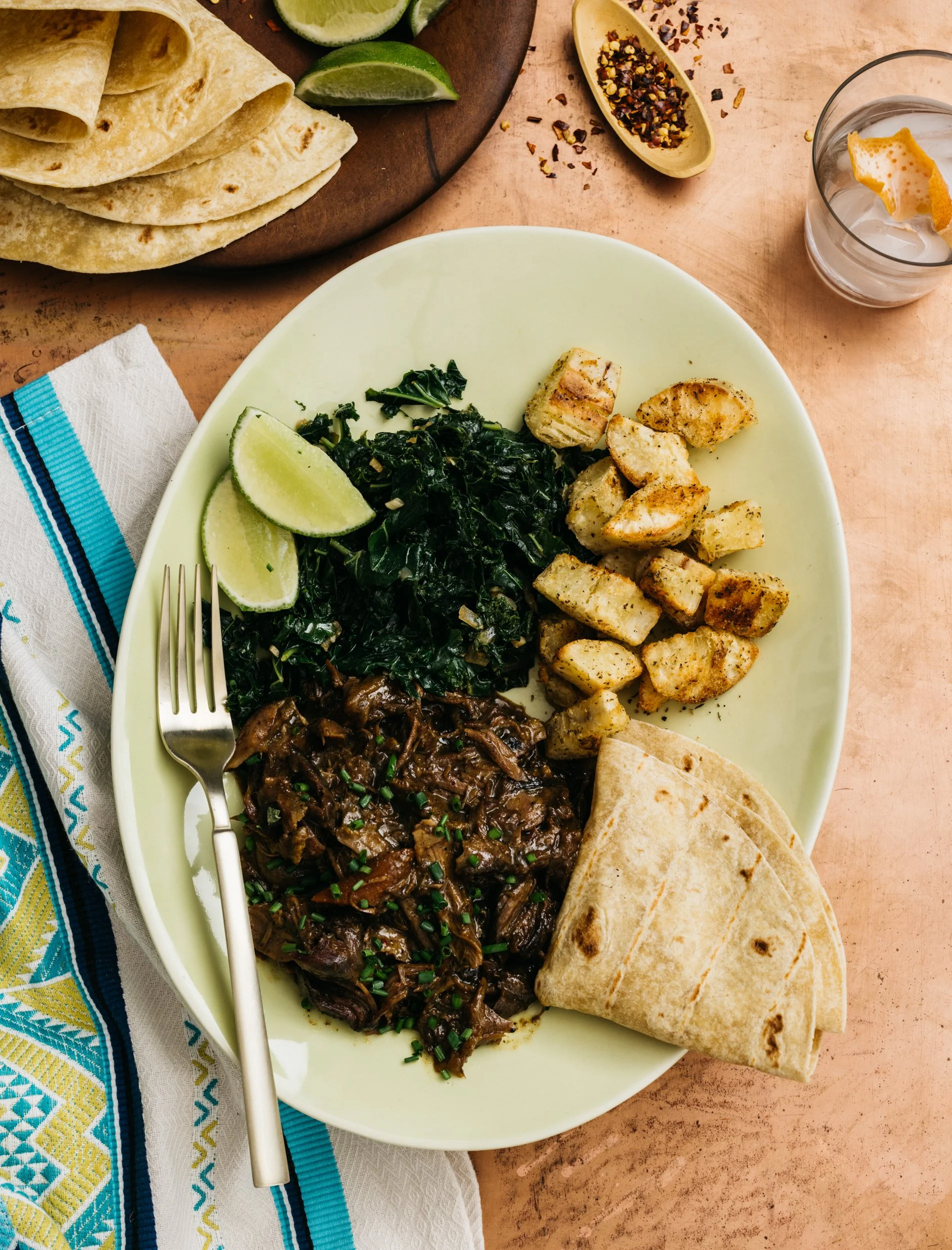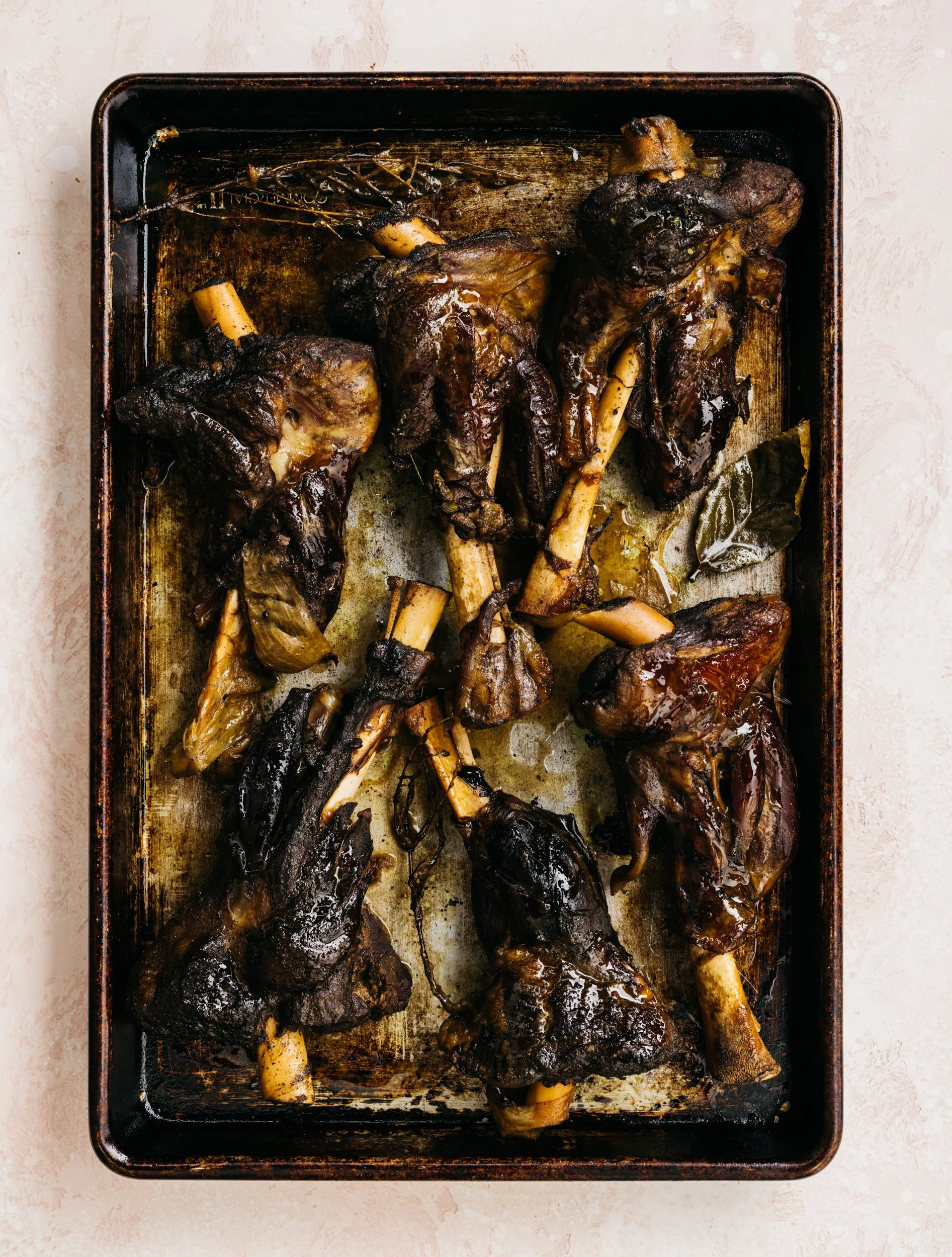Global Braised Goat Shanks with Smokey Sautéed Kale and Roasted Cassava with Pimento Salt
Photos by Michael Piazza / Styled by Catrine Kelty
One night on a visit to Kampala, Uganda, my dear friend Safiatou, who is of Gambian origin, unearthed a tightly wrapped brown paper bag from her freezer and announced it was dinner! It was dibi/afra, a Senegambian grilled goat with onions and mustard—her favorite street food, which her mom had brought from Senegal. She insisted on sharing that precious gift with me, given my appreciation of goat meat. This recipe is a marriage of the classic curried goat recipe my Jamaican grandmother would approve of and the grilled goat meal with chunky onions I enjoyed in Uganda. It can be treated like pulled chicken or pork and used on sandwiches with naan, roti or tacos, or served with Smoky Saut ed Kale and Roasted Cassava with Pimento Salt.
Braised Goat Shanks
Serves 4–6
kosher salt and freshly ground black pepper
1 tablespoon Jamaican curry powder*
2 teaspoons ground cumin
1 teaspoon whole pimento (allspice) berries, ground in a spice grinder or mortar and pestle
1½ teaspoons ground cardamom
1 teaspoon ground turmeric
6 goat shanks, 4–5 pounds total
2 tablespoons olive oil, plus additional as needed
2 medium carrots, peeled and cut into 1½-inch pieces
2 medium onions, peeled and cut lengthwise into 6 wedges
8 cloves garlic, peeled and smashed
1 whole habanero (Scotch bonnet) chili
1½ cups port wine
4 cups low-sodium chicken bone broth or stock
5 sprigs fresh thyme
1 bay leaf
4 whole cloves
For serving:
1/3 cup (lightly packed) chopped cilantro
3 teaspoons chives, finely sliced
packaged naan bread or roti, warmed
Preheat oven to 350 F.
In a small bowl, combine 1 tablespoon plus 1 teaspoon salt with 2 teaspoons black pepper, curry powder, cumin, ground allspice berries, cardamom and turmeric. Place goat shanks on a plate or sheet tray and sprinkle with this spice mix, using your hands to distribute and coat the meat. Cover and place in the refrigerator to marinate for at least 1 hour and up to 2 days. (If extra spice mix collects on the bottom of the tray, reserve it to add to the stew later.)
Set a large Dutch oven with a tight-fitting lid over medium-high heat and add 2 tablespoons olive oil; swirl to coat the bottom of the pan. When the oil shimmers, add goat shanks. Sear on all sides, in batches if necessary so as not to overcrowd the pan, until deeply golden, 5–6 minutes per side, about 18 minutes total. Replenish oil between batches as necessary and adjust heat to prevent over-browning.
Transfer shanks to a plate and add an additional tablespoon of olive oil to the pot. Add carrots, onion, garlic and habanero. Season with salt and pepper and any remaining goat spice mix and sauté , stirring occasionally, until vegetables have softened and are beginning to color on the edges, about 8 minutes.
Add port wine, chicken broth or stock, thyme, bay leaf and cloves to the Dutch oven, scraping to deglaze and loosen any brown bits from the bottom of the pot. Return shanks to pot, nestling them into the liquid in as even a layer as possible. Liquid should come almost to the top of the shanks (add a little water to the pot if necessary). Cover the pot and transfer to the oven. Braise, basting top of shanks with liquid every 45 minutes, until meat is tender and falling off the bone, 3–3½ hours.
Remove shanks from the pot and cover to keep warm. Remove the bay leaf, cloves, thyme stalks and whole chili and discard. Return pot to stovetop and reduce sauce over medium-high heat to desired consistency. Shred the meat from the shanks, discard the bones and return meat to the pot with the sauce. Season with additional salt and pepper to taste.
Divide shredded meat among shallow serving bowls. Surround with Smoky Sautéed Kale, Roasted Cassava with Pimento Salt (recipes below) and some warmed packaged naan or roti. Serve immediately, topped with cilantro and chives.
*For curry powder, I recommend BetaPak from Jamaica and Chief from Trinidad. Both can be found at retailers that carry Caribbean or West African groceries throughout Massachusetts.
Smokey Sautéed Kale
Inspired by a recipe from Jubilee: Recipes From Two Centuries of African American Cooking by Toni Tipton-Martin
Recipes for braised or sautéed leafy greens such as kale, chard, mustard and collards were carried from West Africa and cemented themselves in the African diaspora. Callaloo is ubiquitous throughout the Caribbean, and refers to the amaranth plant, dasheen/taro leaves or a medley of greens cooked in coconut milk. Many urban farms, such as Fowler Clark Epstein in Mattapan, cultivate these Caribbean leafy greens and bring them to Boston area farmers markets from May to October. True callaloo is on hiatus until spring markets begin but kale is an excellent year-round substitute.
Many cooked greens recipes are family heirlooms and passed from generation to generation. The classic African American recipe is often enriched with small pieces of smoked meat like ham or turkey to lend a deep and smoky flavor. The dish is served with classics such as corn bread or Hoppin’ John. The Caribbean version would use tomatoes, onions, scallions and salted codfish.
This version, lightly cooked for a green and vegetal taste, might get rolled eyes from the aunties who prefer a longer-cooked, more traditional pot of braised greens, but it is a simplified, approachable recipe that makes a good companion to rich goat meat dishes. Here, smoked paprika is used to mimic the smoked meat taste. Feel free to substitute Swiss chard, mustard or turnip greens for the kale if you prefer.
Serves 6
3 tablespoons olive oil or unsalted butter
4 cloves garlic, minced
1 yellow onion, chopped finely
1 teaspoon Spanish smoked paprika
1 bunch kale, stemmed removed and sliced into chiffonade
2 cups chicken or vegetable stock (or water)
sea salt and freshly ground black pepper
½ teaspoon red pepper flakes or ground Scotch bonnet, optional
Put the oil or butter, garlic and onions into a big skillet or stockpot set over medium heat. Cook, stirring, until the garlic just begins to brown. Add the paprika, stir, and cook for 30 seconds to bloom its flavor. Add the greens and stock and cover for about 5 minutes. Lower the heat until the stock is just simmering.
Cook until the liquid begins to evaporate, stir, and then cook for an additional 5 minutes over low heat, stirring often. Remove from the heat so that the greens don’t overcook. Season to taste with salt and red pepper flakes or ground Scotch bonnet.
Roasted Cassava with Pimento Salt
Goat is usually served with rice. And whether boiled white rice or rice and red beans accompanies it best is a century-old debate. Serving “ground provision” sidesteps the controversy entirely; rural folks know. Ground provision might include a medley of green bananas, boiled yams, taro or dumplings. It is hearty, readily available since it’s a subsistence crop, and offers fuel for a long day. Cassava, known as yuca or manioc, is a favorite ground provision of mine. The indigenous people of the Caribbean, the Tainos, cultivated the crop long before European invasion, and even had a god (zemi) of yuca. I like the bitter and slightly acidic taste of roasted yuca with rich and flavorful braised goat, especially with smoky saut ed kale. The pimento salt is something I usually make right before I need it, by grinding coarse sea salt and pimento berries with a mortar and pestle to release the pimento oils and flavor.
According to folklore, pimento berries go by the misnomer “allspice” thanks to an English colonist in 1600 who found the berries in Jamaica and thought they had notes of all the spices—cloves, nutmeg, cinnamon and black pepper. My mother’s ancestral roots are in the Cockpit Country, Jamaica’s Amazon forest equivalent, where 80–100-year-old pimento trees are cultivated by the indigenous people, the Maroons, and the berries are used for anti-colic medicine, jerk marinade and in sweet and savory daily cooking. A bowl of pimento berries sits on my countertop next to my salt bowl—always.
Serves 4–6
1 pound frozen yuca root or 1 pound fresh yuca root, peeled, cleaned* and diced
4 tablespoons olive oil
1 teaspoon dried oregano
1 teaspoon garlic powder
salt and black pepper
For serving:
1 teaspoon ground pimento (allspice) and 1 teaspoon coarse sea salt
2 tablespoons fresh lime juice
Preheat oven to 450 F.
In a large pot of salted boiling water, cook the yuca until almost tender, about 15 minutes. (The water should be as salty as the ocean.)
Drain and set aside on a parchment-lined baking sheet.
In a medium bowl, combine the olive oil, oregano and garlic powder. Add a big pinch each of salt and pepper. Transfer the yuca from baking sheet to bowl and toss to coat with the seasoned oil.
Arrange yuca in a single layer on the baking sheet. Roast until yuca is tender and starts to brown, 25–30 minutes. Turn the yuca over at the halfway mark.
Remove the baking sheet from the oven and immediately sprinkle the roasted yuca with lime juice and toss with the pimento salt. Serve warm.
*Yuca sometimes has a long vein-like fiber lengthwise through its center; in larger fresh yuca, this needs to be removed after it is peeled and washed. Smaller yuca may not have this vein, so just remove what looks tough.
These recipes appeared in the Spring 2022 issue as part of a larger story on The Geography of Goat.


